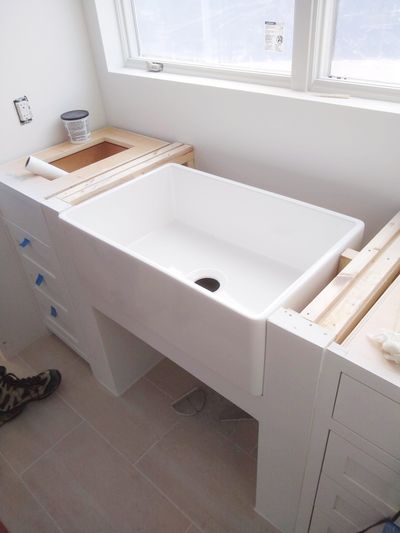Ask the Builder: Apron sinks have more pros than cons

Q. I’m almost certain I want an apron sink in my new kitchen. You’ve got one last chance to talk me out of it. Have you installed one? Do you own one? What are the pros and cons of an apron sink? Are there special things you have to do to install one? I can sometimes be more concerned about looks than how something functions, so if you feel I’ll regret my decision, I need to know now. – Lori T., Riverside, California
A. Before you make a big decision about a major fixture, you really do all your due diligence. You’ve asked all the right questions about apron sinks, sometimes known as farmhouse sinks.
Over the years, I’ve installed my fair share of these sinks. They’re not that hard to install, and it helps to have fine carpentry skills to make the installation go perfectly. As it happens, I have an apron sink in my own kitchen. What’s more, I recently installed two of them in my daughter’s new custom home, one in her kitchen and the second one in her scullery.
I’ve always loved doing plumbing work, and an apron sink connects to your household plumbing sink just as a normal one might. You might not give a second thought about the water and food particles that leave your kitchen sink, but they travel through pipes that must be sized correctly and vented properly. While on the subject of vents, be sure your plumber installs a traditional loop vent if your apron sink will be in an island. Mechanical vents can fail and allow foul sewer gas into your nice new kitchen.
In my opinion, there are many more pros than cons when it comes to apron sinks. Let’s talk about looks first and then functionality. There are many designs when it comes to these sinks. The apron sink almost always projects past the front face of the kitchen sink base cabinet. This extra relief helps draw your eye to the sink, especially if the sink is a different color than the cabinetry.
One of the positive aspects of an apron sink is if you drip water down the front of the sink, it doesn’t harm the sink. With a normal sink, the water might flow onto the wood cabinet below. Some apron sinks have gorgeous designs that are part of the front of the sink, so this helps add character and beauty to the kitchen. Keep in mind you can get single- and double-bowl apron sinks. My own sink is a double-bowl design with one bowl much larger than the smaller veggie-rinse bowl on the right side of my sink.
The only negative thing I can think of is it’s not always easy to replace an apron sink if it needs to be done. Your countertop will overhang the top edge of the sink. This means if you need to remove the sink, it needs to slide out of the opening. This is not too easy to accomplish. What’s more, since the cutout in the base cabinet is very exact, you need to replace the old sink with one that has the exact same measurements.
Let’s say you decide to go with a traditional over-the-counter drop-in kitchen sink. These are quite easy to replace. A talented craftsman might be able to take out an existing sink and replace it with a new one in a couple of hours if everything goes according to plan. Most of these sinks all are about the same size, so the cutout in the countertop will work with many sinks.
Apron sinks require a platform to sit on inside the base cabinet. In my daughter’s case, she had custom cabinets made, and the cabinet maker was able to create the perfect platform inside the cabinet and do the required cutout on the face of the cabinet based on dimensions provided by the sink manufacturer. Her sink fit perfectly into the cabinet. I only had to make a simple circle cut in the platform for the drain hole.
Standard kitchen sink base cabinets can be used with apron sinks, and you just have to build your own platform. A simple piece of 3/4-inch thick A/C fir plywood will provide plenty of support, and a 1x2 cleat screwed into each side of the cabinet will support the platform. Just be sure that the top of the apron sink sits 1/8 inch below the top of the cabinets so you can put a bead of caulk between the countertop and the top of the sink.
Keep in mind the platform for the sink doesn’t extend all the way to the back of the cabinet. Keep it away from the back of the cabinet about 5 inches so you can have access to the underside of the countertop. You’ll need this to be able to install the sink faucet.
Be prepared to shim the underside of the apron sink, especially if it’s a cast iron one. The sinks are not always cast perfectly, and, when sitting on the platform, they may rock back and forth a little bit. You’ll need to shim the sink so it doesn’t move.
I have videos showing how apron sinks are installed and some dramatic photos of the support platform of my daughter’s scullery sink on my website askthebuilder.com. If you’re thinking of having one of these wonderful sinks in your kitchen, I urge you to take a look at the photos and videos. Simply type “apron sink photos” in my search engine, and you’ll find what you’re looking for.
Subscribe to Tim Carter’s free newsletter and listen to his new podcasts. Go to askthebuilder.com.